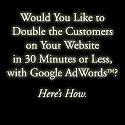

Call-to-Action 101: Why they’re important and how to use them
This is guest contribution from Michael Kuhlmann.
Would you like to increase your readership? How about boosting downloads for your latest white paper or newly-launched digital product?
The secret to success sometimes lies in the obvious.
While you may have placed a sign-up field for your newsletter or added a new product to your e-commerce site, your job as a content marketer doesn’t end there. You need a CTA, a call-to-action!
The easiest way to start is by answering the “why” question. Why should somebody subscribe to your blog? Or, why should I buy this new product? The answer can be anything from “Buy 1, Get 2 Free!” to “Sign up today and never miss another post!”
Finish the race
When you’re ramping up a marketing campaign through an email, landing page or any other asset, it’s easy to get lost in the offer and messaging. You’ll talk about all the amazing things your customers will want and maybe even include a bulleted list of why your goods and/or services are so awesome. You might even throw in the “time-limited offer” verbiage to incentivise your customers.
After you add your button that reads “click here” somewhere in your content, you might be inclined to call it day. Don’t! You’ll just have wasted a lot of time and effort on what’s, really, your first draft.
Let’s backtrack a little.
Every form of communication with your customer should begin and/or end with a call to action. While it’s easy to point out the importance this carries over your marketing efforts, it’s best explained through an example. Consider the following marketing copy for an email:
Scenario
Unilever announced it will sell a new body spray this December called Squirrel-Off, which is intended to repel food-begging squirrels.
Call to action: Example A
Ward off those pesky squirrels this holiday season with Squirrel-Off!
Call to action: Example B
Keep squirrels away this holiday season with Squirrel-Off, the amazing scented body spray that protects you from those unwanted critters.
Example A sounds abrupt, lacks any type of interaction with the reader and isn’t warm or fuzzy. Example B, on the other hand, is more descriptive and increases the click-through rate (CTR) by linking the bolded call to action in addition to the advertised product.
Split testing your call to action

To calculate the effectiveness of the marketing copy with and without a call to action, we can refer to what’s called an A/B split-test.
A lot of email service providers (ESPs) have a built-in functionality to measure this, but for the sake of keeping things simple, let’s assume we have a database of 200 contacts. If we also assume that our ESP is fairly basic without a simple or automated A/B split-testing functionality, then we can halve our contacts and send them the marketing copy with the contents from Example A and the other 100 people receive the contents from Example B. The CTR from the latter email should yield higher.
Calculating the effectiveness of CTAs doesn’t hinge solely on the email copy nor on the medium in which you use it, and it doesn’t have to be time-consuming or complicated.
For example, if you’re not too keen on fiddling with Google Analytics and have a fair marketing budget, you can use Optimize.ly or Visual Website Optimizer on your landing pages. You can perform split-tests on your hero shot and call to action buttons, as well.
Does a red pill button outperform a blue pill button? How about button with a chevron or triangle? The possibilities to what you can measure are endless, but the common denominator will always be your content, your call to action.
To hone down on your CTA, you’ll want to answer five questions.
1. Does your first sentence grab your attention enough to continue reading?
An easy way to figure this out is to think of your favourite product or service and substitute it for the actual product or service you’re promoting. If you’re thinking, “Sure, this sentence is still good enough” stop right there and revise it, because your first sentence needs to be excellent!
When it’s excellent, the road is paved for your customers to keep reading your content, which will increase the chances for them to perform an action – starting a trial, getting a discount, downloading a document, etc.

2. Do you have emphatic CTAs sprinkled throughout your content?
If you think your call to actions might be a bit weak and you’re worried about making them sound too “sales-y”, don’t worry. Make them sound “sales-y”. Obviously, you don’t want every sentence to have a link pointing to your product or service, but your call to action should be noticeable throughout your content.
The worst thing you can do is have a boring call to act
ion that nobody cares enough to click on, which brings up the next question.
3. Have you linked your CTAs?
Sure, you can expect people to read your entire content and scroll down to click on your awesome call to action button, but let’s not be so lazy. Your customers need a bit of hand-holding and that requires you to give them more than one way to click on things. For example, if you’re prompting them to “discover new music”, then make sure to link your CTA to the appropriate page.
4. Are you tracking your CTAs?
Hopefully, the answer is always “Yes”. If you’re shrugging your shoulders, link-tracking simply means you’re counting how many times people have clicked on your linked call to action.
You can use tools like Google URL Builder or Bit.ly or any other tracking method for that matter. You’ll want to get into the habit of continuously measuring your marketing efforts, as that will help you promote your products and/or services more efficiently. It takes a bit more time, but you’ll make much more informed decisions for your next campaign.
5. Are you using a pill-shaped “Click Here” button?
Yes? Shame on you!
That type of marketing belongs next to the blinking text from the late 90s. If you want people to start a trial, your pill-shaped call to action button should read “Start Your Trial” … and, yes, make that title-case, because it stands out more. Don’t be vague! People should be able to look at your CTA button and figure out what happens before they click on it.
Once you’ve tweaked your content, give yourself a pat on the shoulder and a quick breather, because you’ve just scratched the surface on optimising your marketing effort starting from your call to action.
Michael Kuhlmann is a highly-caffeinated content creator at Quote Roller. When he’s not writing stuff, he spends time with his shutterbug wife, teeny toddler and West Highland White Terrier named Beary White who has a Napoleon complex.
Originally at: Blog Tips at ProBlogger
Call-to-Action 101: Why they’re important and how to use them
Facebook comments:
No Comments »
No comments yet.
RSS feed for comments on this post. TrackBack URL
Leave a comment
















